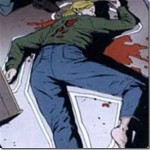ERA LA HORA EN QUE MATARON A LOLA.. !
Si Ud. es cubano y le preguntan.. A que hora mataron a LOLA….. Ud.deberáa de responder inmediatamente…. a las 3.oo de la tarde..
Lola, es el nombre de una leyenda popular cubana.
La leyenda trata sobre el asesinato de una mujer a manos de su esposo, cuando éste, un día a las tres de la tarde, le descubrió siéndole infiel con otro hombre. El crimen puede ubicarse en la primera mitad del siglo XX cubano, si bien el nombre de Lola era común y se hace difícil ubicar geográficamente el origen de la leyenda. A esta dificultad se suma, lamentablemente, en aquella época, una diversidad de anécdotas similares de crímenes pasionales lo que hace aún más difícil establecer sus orígenes o protagonistas. Diversas leyendas urbanas han atribuido el protagonismo de la historia a personajes célebres de la cultura y la política nacional.
Otra version nos dice que Lola era una prostituta de La Habana y la mató uno de sus amantes. No pudo soportan que fuera tan puta y le clavó un puñal en el pecho. El suceso se produjo a las tres de la tarde y su victimario que dicen era médico pensó que el crimen sólo ocuparía dos líneas en los titulares de la prensa capitalina de la tarde.
El asesinato de «La bella murciana» fue uno de los crimenes más sonados de la Cuba de las primeras décadas del siglo XX. La muchacha, que vivía en un edificio de la esquina de Nueva del Pilar y Belascoaín, fue víctima del médico Edmundo Mas. ¿Fue ese suceso lo que inspiró el bolero-son de Rafael Hernández?
Hernández vivió en La Habana entre 1919 y 1922. En esa época el compositor, nacido en 1896, trabajó como trombonista en la orquesta del teatro Fausto, de esta capital. Cuando regresó en 1939 era ya todo un maestro a quien intérpretes y compositores cubanos admiraban. Viene comisionado en esta segunda ocasión por el sello discográfico Víctor para hacer grabaciones con orquestas y agrupaciones del patio. Trabaja entonces con la orquesta Riverside, bajo la dirección de Enrique González Mántici, y con la de Alfredo Brito que, por deferencia del cubano, conduce el propio Rafael Hernández.
Lola es un bolero-son de Rafael Hernández, que grabó el cuarteto Machín en Nueva York, en noviembre 27 de 1935. No recuerdo que en alguna declaración Rafael aclarase si se refería a un hecho real, que pudo haber sucedido en Puerto Rico o en Cuba, donde también vivió, y más probable todavía en Nueva York o en México, donde vivió en fecha más cercana a su composición, según el relato del maestro Díaz Ayala.
El suceso puede haber extendido su fama cuando el presidente Ramón Grau San Martín, durante uno de sus discursos, consultó su reloj y exclamó “¡Coño, son las tres de la tarde, la hora en que mataron a Lola!”, popularizándose aún más la expresión. Más allá de lo escabroso y del contenido violento y machista de la supuesta historia, el cubano la ha despojado totalmente de esos significados y la ha trasladado de manera erótico-festiva a su código de conducta social diario: Al ver a otra persona inclinada hacia delante, se le suele avisar jocosamente de que en esa posición mataron a Lola. En Cuba, las tres de la tarde se define mediante la expresión: “la hora en que mataron a Lola”.
Ese comentario tan simple, pero relevante por haberlo expresado el Presidente de la República, repercutió de inmediato y quedó acuñado en el imaginario y la memoria colectiva de los cubanos, al punto de que no hay oriundo de la Isla que no sepa la hora en que mataron a Lola. Como si eso fuera poco, una canción, digamos con exactitud, un bolero-son, se encargó de perpetuar el incidente: «Eran las tres de la tarde / cuando mataron a Lola… / y dicen los que la vieron / que agonizando decía: / yo quiero ver a ese hombre / que me ha quitado la vida / yo quiero verlo y besarlo / para morirme tranquila».
Estar “mejor que Lola”, refiere por su parte un estado de disfrute máximo. “¡Adiós, Lolita de mi vida…!” fue la expresión de un conocido comentarista deportivo en la Isla para narrar en un partido de béisbol el momento en que la bola era sacada del parque (home run). Ésta última suele utilizarse además como despedida irónica. Diversas melodías populares cubanas también hacen frecuente alusión a Lola.
En Cuba, las tres de la tarde se define mediante la expresión: “la hora en que mataron a Lola”. Estar “mejor que Lola”, refiere por su parte un estado de disfrute máximo. “¡Adiós, Lolita de mi vida…!” fue la expresión de un conocido comentarista deportivo en la Isla para narrar en un partido de béisbol el momento en que la bola era sacada del parque (home run). Ésta última suele utilizarse además como despedida irónica. Diversas melodías populares cubanas también hacen frecuente alusión a Lola.
Rajatabla/Bianchi/DiazAyala/InternetPhoto/YouTube.TheCubanHistory.com
IT WAS THE TIME WHEN LOLA WAS KILLED!
The Cuban History, Hollywood.
Arnoldo Varona, Editor
IT WAS THE TIME when Lola was Killed !
If you are a Cuban and somebody ask you.. at what time LOLA was killed….. you should answer IMMEDIATELY…. it was at three in the afternoon.
LOLA is the name of a Cuban folk legend.
The legend is about the murder of a woman by her husband, when he, one day at three in the afternoon, discovered being unfaithful with another man. The crime can be located in the first half of twentieth century Cuban, although the name Lola was common and it is difficult to geographically locate the source of the legend. Adds to this difficulty, unfortunately, at that time, a variety of similar stories of crimes of passion which makes it more difficult to establish their origins or protagonists. Various urban legends have attributed the role of history celebrities of culture and national politics.
Another version says that Lola was a prostitute in Havana and killed one of her lovers. He could not bear that out as a bitch and stuck a dagger in the chest. The accident occurred at three in the afternoon and the perpetrator was a doctor saying he thought that crime would take only two lines in the headlines of late capital.
The murder of “Beauty Murcia” was one of the most notorious crimes of the Cuba of the early twentieth century. The girl, who lived in a building on the corner of New and Belascoaín Pillar, was a victim of medical Edmundo More. Was this event that inspired the bolero-son of Rafael Hernández?
Hernandez lived in Havana between 1919 and 1922. At that time the composer, born in 1896, worked as a trombonist in the orchestra of the theater Faust, in this capital. When he returned in 1939 was already a teacher who admired Cuban performers and composers. Commissioner comes this second time by the Victor label to make recordings with orchestras and groups in the courtyard. Then works with the orchestra Riverside, under the direction of Enrique Gonzalez Mantici, and the Alfredo Brito, in deference of Cuban Rafael Hernandez leads himself.
Lola is a bolero-son of Rafael Hernandez, who recorded the quartet Machin in New York, November 27, 1935. I do not recall any disclosure Rafael clarify whether he was referring to a fact that could have happened in Puerto Rico or Cuba, where he lived, and most likely still in New York or Mexico, where he lived on a date closest to your composition, according to the account of maestro Díaz Ayala.
The event may have extended his fame when President Ramon Grau San Martin, during one of his speeches, looked at his watch and said “Damn, it’s three in the afternoon, when they killed Lola!” Further popularized expression. Beyond the rough and violent and sexist content of the supposed history, Cuban has completely stripped of those meanings and moved so erotic holiday to its code of social behavior diary: Watching another person leaning forward , is often jokingly tell you in that position killed Lola. In Cuba, three in the afternoon defined by the expression: “When Lola was killed.”
That comment so simple, but relevant for having expressed the President of the Republic, had an immediate impact and was coined in the minds and collective memory of the Cubans, to the point that no native of the island who does not know the time Lola killed. As if that were not enough, a song, say with accuracy, a bolero-son, was responsible for perpetuating the incident: “It was three in the afternoon / when they killed Lola … / and those who saw it say / that dying he said: / I want to see the man / that has killed me / I want to see him and kiss him / to die quietly. ”
Being “better than Lola”, refers in turn a state of maximum enjoyment. “Goodbye, Lolita of my life …!” was the expression of a well-known sports commentator on the island to tell in a baseball game when the ball was taken out of park (home run). The latter is often used also as ironic farewell. Several Cuban folk melodies also make frequent reference to Lola.
In Cuba, three in the afternoon defined by the expression: “When Lola was killed.” Being “better than Lola”, refers in turn a state of maximum enjoyment. “Goodbye, Lolita of my life …!” was the expression of a well-known sports commentator on the island to tell in a baseball game when the ball was taken out of park (home run). The latter is often used also as ironic farewell. Several Cuban folk melodies also make frequent reference to Lola.
Rajatabla/Bianchi/DiazAyala/InternetPhoto/YouTube.TheCubanHistory.com
IT WAS THE TIME WHEN LOLA WAS KILLED!
The Cuban History, Hollywood.
Arnoldo Varona, Editor



 .. IT WAS THE TIME when Lola was Killed ! (Video/Foto ) * * .. ERA LA HORA en que Mataron a Lola !. (Video/Foto).
.. IT WAS THE TIME when Lola was Killed ! (Video/Foto ) * * .. ERA LA HORA en que Mataron a Lola !. (Video/Foto).




